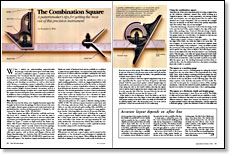The Combination Square
A patternmaker's tips for getting the most out of this precision instrument
Synopsis: Early in Benjamin A. Wild’s woodworking career, he learned the value of using a combination square to set up and check out machines, as well as other layout work. It’s a marking gauge and a height, depth, and thickness gauge, it transfers lengths of preset measure, and accessories extend its usefulness. In this article, he discusses some of the basic considerations for buying and using a combination square. He talks about how to evaluate quality when buying one, how to care for and maintain a square, and how to use it in some of the ways mentioned above. He also offers advice on the best ways of marking measurements.
When I started my pattern making apprenticeship 16 years ago, I was told to show up for work with a hammer and a combination square. I understood the need for a hammer, but I wondered why the square was so important. Besides the obvious use of laying out square and 45° miter lines, I soon found the combination square indispensable for accurately setting up and checking out machines as well as other layout work. Because a combination square is adjustable, it works quite well as a marking gauge and a height, depth and thickness gauge. It also transfers lengths of preset measure. Accessories, such as a protractor head for laying out angles and a center head for finding the center of round and square stock, extend the tool’s usefulness. In addition to these techniques, I’ll discuss some of the basic considerations for buying and using one of these versatile instruments.
Buy quality
When the boss saw the shiny, new, bargain-basement square that I bought, he threw it into the garbage. He then took me to the store and bought a Starrett square, protractor and center head set for me and deducted the cost from my first paycheck.
That Starrett square has fallen off benches, scaffolds and boats. The level vial is smashed, the scriber is lost and the paint is chipped. Recently, I put a 24-in. blade into it, set it on a surface plate (a precision ground granite table) and put it up against a 24-in. machinist’s try square. I couldn’t see light between the blades anywhere. After 16 years of hard use, it’s as good as the day it was made. The cheap square, which I secretly retrieved from the garbage, went out of square and was thrown into Dad’s toolbox years ago.
Quality materials and precision machining set the Starrett and other good squares, such as Brown and Sharpe’s, apart from runof-the-mill squares. The heads are forged and hardened; the rule blades are made of hardened steel and are available in a polished or satin-chrome-plated finish. I recommend the satin-chrome finish because it reduces reflection and glare, making the rule much easier to read. As a bonus, the chrome plating protects the blade from rust and wears exceptionally well.
Starrett squares also have what the manufacturer refers to as “quick reading graduations,” which are staggered graduations with the inch subdivisions numbered as well as the inches, as shown in the photo above. A variety of graduation schemes are available, from all fractional, decimal or metric to some combination of these divisions. The decimal graduations, because of their predominant use in the aerospace industry, have become known as aircraft scales.
From Fine Woodworking #96
For the full article, download the PDF below:
Fine Woodworking Recommended Products

Veritas Micro-Adjust Wheel Marking Gauge

Lie-Nielsen No. 102 Low Angle Block Plane

Stanley Powerlock 16-ft. tape measure






















Log in or create an account to post a comment.
Sign up Log in